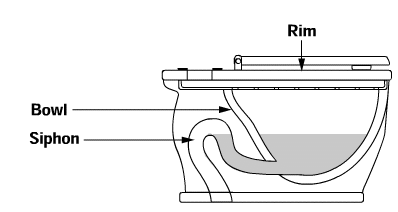To accelerate the water in a circuit and to overcome frictional forces while
maintaining a steady flow, you use a pump. Pumps create pressure
gradients. To accelerate a column of water, a pump either increases the
pressure on one side of the column, or decrease the pressure on the other side
of the column.
Consider a simple U-shaped pipe filled with water. The water level is the
same in each leg and the pressure on each surface is the atmospheric pressure.
How can you make the water level rise in the right leg and sink in the left leg?
 (a) You can blow into the left side of the tube. You add air
molecules. The density of the air in the left leg increases. The air
pressure increases. The water accelerates towards the right.
(a) You can blow into the left side of the tube. You add air
molecules. The density of the air in the left leg increases. The air
pressure increases. The water accelerates towards the right.  (b) You can suck on the right side. You remove air molecules. The
density of the air in the right leg decreases. The air pressure decreases.
The water accelerates towards the right.
(b) You can suck on the right side. You remove air molecules. The
density of the air in the right leg decreases. The air pressure decreases.
The water accelerates towards the right.
If you remove all the air above one leg, you establish a pressure
difference of 1 atm = 101 kPa. You can then support a column of water 10.3 m high. The density of water is 1000 kg/m3.
1 m3 of water weighs 9800 N. So a column of water 10.3 m high will
exert a pressure of 101 kPa. Many pumps operate
on the simple principle of pushing and sucking. However, you can never suck
water out of a well, when the water level is more than 10 m below the pump.
In a vertical, water-filled pipe gravity creates a pressure gradient in the
water. The water below has to support the weight of the water above. The
pressure exerted by 10 m or 33 feet of water overhead is equal to the
atmospheric pressure at sea level. One way of maintaining pressure in plumbing
is to have tall columns of water connected to the pipes. Many municipalities
use a water tower build at a relative high site within their service region to
maintain pressure in the water mains.
Siphons
Suppose a U-shaped piece of pipe is completely submerged in water, filled
with water, and then turned upside down under water. As you slowly pull the top
of U-shaped piece of pipe out of the water, the water does not run out of the
pipe. Why?

Air cannot enter the pipe. As the water starts running out of the pipe, a
near vacuum is created in the topmost region of the inverted U. The pressure
here drops to near zero. The atmospheric pressure on the surface of the water
in the bucket pushes the water into the U-shaped pipe.
If a U-shaped hose or pipe connects a liquid-filled container at a higher
altitude to a container at a lower altitude over a barrier, the liquid can be
siphoned into the container at lower altitude. Atmospheric pressure helps
to push the liquid over the barrier. In the diagram below P1 > P2,
and the fluid is siphoned from the left to the right bucket.

For a static situation we would have Pbelow = Ptop + ρhg.
Here Pbelow = 1 atm.
Therefore Ptop
= P1 = 1 atm - ρh1g on the left side,
and Ptop
= P2 = 1 atm - ρh2g on the right side.
P1 > P2, there is a net force on the fluid at the top,
pointing towards the right.
The situation is not static, the liquid starts flowing.
Application:
The toilet

Initially the pressure is the same everywhere where there is no water.
It is atmospheric pressure. When you flush, the water first rises in the bowl
above the highest point in the siphon. Now there is a continuous water
column between the top of the bowl and the bottom outlet of the siphon.
The pressure at the bottom of this column is Pbelow = Patm
+ ρhg, where h is the height of the water in the bowl. This cannot be
balanced by atmospheric pressure alone, and the water starts flowing. As
long as no air can get into the siphon Pbelow will higher than Patm
and the water will keep flowing towards the bottom. Once air gets into the
siphon, the water on the left side will flow out, and things will be in
equilibrium again on the right side of the picture.
Link:
The flush toilet (Youtube)
Here are some experiments you can try at home with links to corresponding
YouTube videos.
Try it! Investigating Pressure
 (a) You can blow into the left side of the tube. You add air
molecules. The density of the air in the left leg increases. The air
pressure increases. The water accelerates towards the right.
(a) You can blow into the left side of the tube. You add air
molecules. The density of the air in the left leg increases. The air
pressure increases. The water accelerates towards the right.  (b) You can suck on the right side. You remove air molecules. The
density of the air in the right leg decreases. The air pressure decreases.
The water accelerates towards the right.
(b) You can suck on the right side. You remove air molecules. The
density of the air in the right leg decreases. The air pressure decreases.
The water accelerates towards the right.

